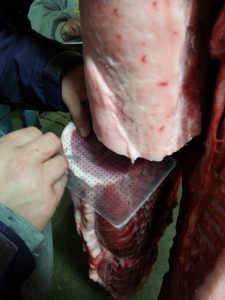Carcass Contests-where county fair market livestock animals are judged on the quality and quantity of meat product post-butcher, are an important way to enhance the educational value of the youth livestock project. Rather than being judged live, walking in a show ring where an individual judges and places an animal based on its structure and potential meat product it could produce, the Carcass Contest judges the animal based on total lean meat product produced. The contest connects the show ring to real-world agriculture, the production of a safe, quality meat product for the consumer.
Carcasses of the market steer and market hogs are judged one week after the fair based on several criteria: carcass weight, ribeye/loin eye size, marbling, and exterior rib fat. Additionally USDA Quality (palatability attributes) and Yield (percent of carcass weight in boneless trimmed retail cuts from the round, loin, rib, and chuck) Grades are used for steers. For market hogs, the carcasses are ranked on “percent lean” produced while having more than 85 pounds of lean meat, loin eye between 5.0 and 9.0 inches, a carcass weight of 170 lbs and live weight 240 to 300 lbs, and rib fat within 0.5 to 1.2 inches. These criteria match what the industry and consumer are looking for in a wholesome meat product. Beef carcass judging is more subjective, including a subjective measurement of marbling (intramuscular fat) in the ribeye, percent kidney, heart, and pelvic fat which are used to calculate the USDA Quality (Prime, Choice, Select, etc) and Yield (1 to 5) Grade.
This year, 21 beef project members and 55 swine project members participated in the Carcass Contests held at Loehr’s Meat Market (swine) and Beck’s Meats (beef). Youth had the opportunity to learn about cuts of meats and see their carcass and try judging themselves. In the swine carcass contest, the winning hog carcass provided 57.3% lean product with a 9.0 loineye. To put this in perspective, the average dinner plate is between 10 and 11 inches in diameter! The winning beef carcass was a choice carcass with a yield grade 2.8. The carcass has a 62.4 percent dressing with a 14.4 inch ribeye.





